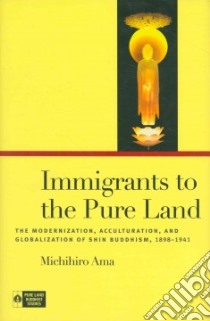Immigrants Pure to the Land - 9780824834388
Un libro in lingua di Michihiro AMA edito da Univ of Hawaii Pr, 2011
- € 43.90
- Il prezzo è variabile in funzione del cambio della valuta d’origine
Religious acculturation is typically seen as a one-way process: The dominant religious culture imposes certain behavioral patterns, ethical standards, social values, and organizational and legal requirements onto the immigrant religious tradition. In this view, American society is the active partner in the relationship, while the newly introduced tradition is the passive recipient being changed. Michihiro Ama's investigation of the early period of Jodo Shinshu in Hawai'i and the United States sets a new standard for investigating the processes of religious acculturation and a radically new way of thinking about these processes.
Most studies of American religious history are conceptually grounded in a European perspectival position, regarding the U.S. as a continuation of trends and historical events that begin in Europe. Only recently have scholars begun to shift their perspectival locus to Asia. Ama's use of materials spans the Pacific as he draws on never-before-studied archival works in Japan as well as the U.S. More important, Ama locates immigrant Jodo Shinshu at the interface of two expansionist nations. At the end of the nineteenth and beginning of the twentieth centuries, both Japan and the U.S. were extending their realms of influence into the Pacific, where they came into contact---and eventually conflict---with one another. Jodo Shinshu in Hawai'i and California was altered in relation to a changing Japan just as it was responding to changes in the U.S. Because Jodo Shinshu's institutional history in the U.S. and the Pacific occurs at a contested interface, Ama defines its acculturation as a dual process of both "Japanization" and "Americanization."
Immigrants to the Pure Land explores in detail the activities of individual Shin Buddhist ministers responsible for making specific decisions regarding the practice of Jodo Shinshu in local sanghas. By focusing so closely, Ama reveals the contestation of immigrant communities faced with discrimination and exploitation in their new homes and with changing messages from Japan. The strategies employed, whether accommodation to the dominant religious culture or assertion of identity, uncover the history of an American church in the making.
Informazioni bibliografiche
- Titolo del Libro in lingua: Immigrants Pure to the Land
- Sottotitolo: The Modernization Acculturation and Globalization of Shin Buddhism 1898-1941
- Lingua: English
- Autore: Michihiro AMA
- Editore: Univ of Hawaii Pr
- Collana: Univ of Hawaii Pr (Hardcover)
- Data di Pubblicazione: 31 Marzo '11
- Genere: SOCIAL SCIENCE
- Argomenti : Shin (Sect) United States History 20th century Shin (Sect) Hawaii History 20th century
- Pagine: 313
- ISBN-10: 0824834380
- EAN-13: 9780824834388


